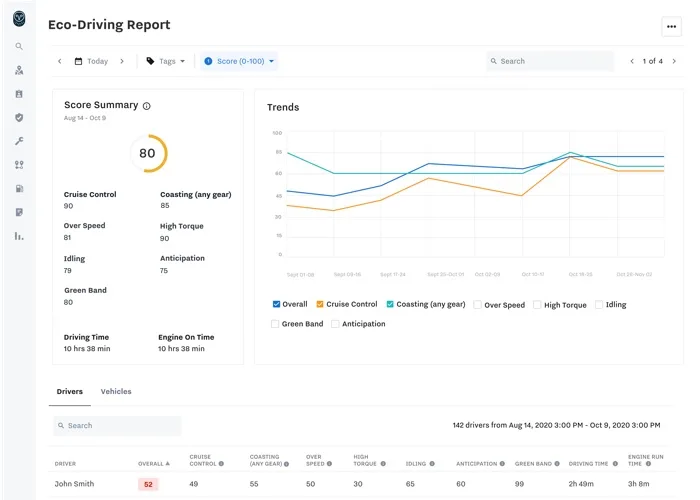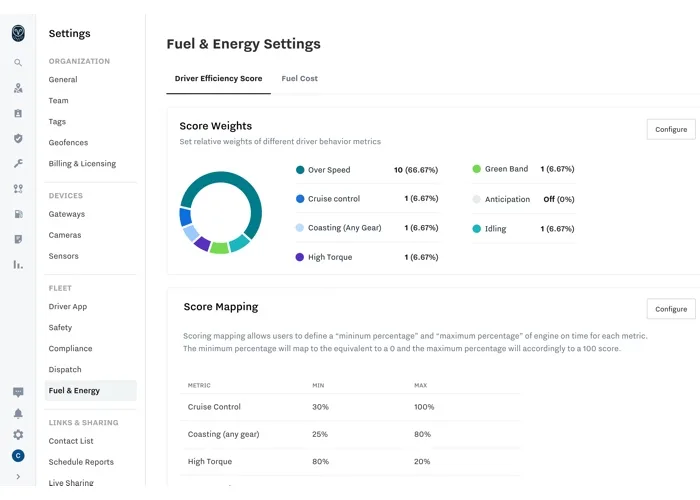Efficiency
New Driver Efficiency Score Improves Driver Behavior to Decrease Costs
May 28, 2020

Get the latest from Samsara
Subscribe nowFleets across the country are adjusting their operations to meet changes set in motion by the current economic climate. This industry-wide response to shifting levels of demand—with surges comparable to demand before Thanksgiving day—highlights a greater need for efficiency. For some fleets, this means extending the longevity of their assets or finding ways to reduce wear and tear, while for others it means getting more mileage out of less fuel. Either way, the goals are the same: get the most value out of what you already have and find ways to reduce costs. To accomplish this, fleet managers are turning to predictive analytics or data that can help better anticipate future events or trends.
Monitoring simple driver habits like acceleration, deceleration, coasting, cruising, and more can have a major impact on your overall operations, your bottom line, and your fuel efficiency. These driving habits, though seemingly inconsequential, can in aggregate have a significant impact on fuel expenses, mechanical repairs, and vehicle lifespan.
By collecting the right data from your connected vehicles, you can gain insights that might otherwise be difficult or impossible to uncover. Read on to learn how your fleet can use telematics to identify, collect, and interpret key driver data points.
Unlocking driver data that moves the needle
Drivers play a huge part in the performance of the vehicles they’re driving. Tracking driver behavior can help you quickly identify the biggest opportunity for cost-savings. While each fleet has different priorities, there are simple driving techniques that can decrease the wear and tear on your vehicles to reduce fuel consumption and promote sustainability:
Maintain a steady speed: When a driver’s speed suddenly increases or decreases, the vehicle can consume 20% more fuel. But beyond increased fuel spend, maintaining a consistent speed (at the minimal throttle and with the transmission in the highest gear) will keep your vehicles on the road longer. Optimal speed varies by vehicle type, but is typically somewhere between 35 mph (56 km/h) and 50 mph (80 km/h).
Engage cruise control: When used in the right conditions, cruise control can help maintain speed. When a driver is in cruise control, the accelerator is disengaged which is ideal for certain types of driving that require a steady speed—like when a driver is on the freeway. But, it’s important to not over-rely on cruise control. It can actually be worse for your vehicle when there’s heavy traffic, winding roads, or icy conditions.
Anticipation & coasting: Each time a driver uses the brakes, they lose forward momentum. But by anticipating traffic, pedestrians, and traffic lights, drivers can determine when it’s time to slow down—well in advance. Minimizing acceleration and braking while maximizing coasting reduces friction on the engine, saving on gas and repairs and adding to your vehicle’s lifespan.
Reduce unproductive idling: When a driver keeps an engine running, they add more wear on the vehicle and increase overall cost per mile. While it’s necessary for certain types of vehicles to idle in moderation, like while they’re in power take-off mode, fleets can save up to $6,000 per vehicle by minimizing unnecessary idle time.
Stay in the green band: When a vehicle stays in the most efficient RPM—also known as the green band—the engine works less hard. If your driver is operating at a higher RPM, your vehicle will burn fuel faster and the engine can more easily incur damages that can lead to costly maintenance repairs.
By following and tracking the results of these driving habits with the help of a telematics provider, you can make vehicle efficiency a competitive advantage for your fleet. Plus, by helping your drivers better understand expectations, you can shift behaviors to create a lasting impact on your fleet-wide efficiency goals and cost savings. Through regular coaching or an awards program, you can align driver incentives with best practices and make efficient driving a priority. This can ultimately help you save money, reduce downtime, and get more out of your assets, while also creating a greener fleet.
Track your fleet with the Samsara Fleet Efficiency Report

Today, Samsara is excited to announce the Driver Efficiency Report which can help you surface inefficient driving habits, incentivize good behavior, and facilitate effective feedback. Its central feature is the efficiency score, which aggregates a number for your fleet based on seven different criteria:
Idling: Time spent with the vehicle on and not moving for more than two minutes, excluding times where PTO or auxiliary inputs are engaged.
Over speed: Time spent over the efficient speed threshold.
Cruise control: Time spent with cruise control on and the accelerator disengaged.
Coasting: Time spent without engaging the accelerator.
High torque: Time spent with engine torque greater than 90%.
Anticipation events: Number of braking events where the time from accelerator to brake is less than one second.
Green band: Time spent in the most efficient RPM.
By carefully tracking this information, the Samsara Driver Efficiency Report can help you establish goals for your fleet and help your drivers understand efficiency best practices. This report also enables you to coach drivers on efficient driving behavior. By helping them understand exactly what goes into a score, they can see how they are being evaluated along with ways to improve.
The Samsara Efficiency Report can help you understand the impact of your coaching, as well. The report’s efficiency trends graph plots how each driving behavior changes over time, so that you can easily visualize how coaching efforts or programmatic changes impact your fleet’s efficiency. You can also customize the weighted score to reflect the metrics that matter most to your fleet. For example, if your routes are primarily along windy roads—where coasting can be worse for vehicles—you can simply give that category less weight or remove it from the score altogether.
Understanding these data insights helped Samsara customer and poultry processor Mar-Jac Transportation, LLC. take action with their fleet. “Coaching drivers on their driving drove the change for us,” said Alan Hewell, a fleet manager at Mar-Jac Transportation. “We’re well above a mile a gallon since we started and we’ve been able to set parameters for incentive and fuel bonus programs.”

To learn more about how Samsara can help your fleet understand and measure efficiency, while coaching drivers on efficiency best practices, check out our complete guide to improving fleet efficiency or reach out for a free trial today.
Get the latest from Samsara
Subscribe now
















